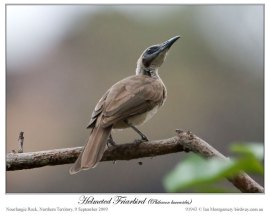Newsletter 03-10-2010
As with the Pheasant Coucal last week, I didn’t have to leave the house to photograph the Helmeted Friarbird in the first photo on the red flowers of a nearby Umbrella Tree. This tree has been flowering profusely for weeks and attracting a noisy variety of Honeyeaters and Lorikeets. The Helmeted Friarbird – length to 37cm/15in is the largest of the 4 species of Friarbirds found in Australia. Friarbirds get their name from the colour of the plumage, like the brown habits worn by friars and Helmeted refers to the feathered crown, in contrast to the naked crown of the more widespread Noisy Friarbird.
This particular individual is sub-adult; it has pale fringes to the feathers of the back and neck which marks it as an immature bird, but it has the red eye and knobbed bill of the adult – very young birds have brown eyes and lack the knob. The second photo shows an adult bird feeding on an orange Grevillea and you can see that the plumage is more evenly coloured.
The Helmeted Friarbird is a northern species and, in Australia, it occurs only in Queensland and the Northern Territory. The Queensland race of the Helmeted Friarbird (yorki) has a silvery crown and is best distinguished from the rather similar Silver-crowned Friarbird by the shape of the rear edge of the facial skin – curved in the Helmeted, but with a backward-pointing spur in the Silver-crowned – and by its calls. In the Top End of the Northern Territory, another race of the Helmeted Friarbird (ammitophila) lacks the knob on the bill – see the third photo – and has different calls. This race is often called the Sandstone Friarbird and is a characteristic bird of the escarpments of Kakadu and Arnhem Land.
Friarbirds are large Honeyeaters and the Helmeted Friarbird is only in exceeded in size among Australian Honeyeaters by the Yellow Wattlebird, a Tasmanian endemic. Only the Silver-crowned is an Australian endemic, the other 3 species also occur in New Guinea, where another 12 species of Friarbird occur.
Noisy Friarbird
Little Friarbird
On the subject of Honeyeaters, I’ve added new photos of Banded Honeyeaters and Yellow-tinted Honeyeaters to the website:
Best wishes,
Ian
—
Ian Montgomery, Birdway Pty Ltd,
454 Forestry Road, Bluewater, Qld 4818
Phone: +61-7 4751 3115
Preferred Email: ian@birdway.com.au
Website: http://birdway.com.au
Lee’s Addition:
Friarbirds and Honeyeaters are both in the Meliphagidae Family of the Passeriformes Order.
“The friarbirds (also called leatherheads) are about 15 species of relatively large honeyeaters in the genus Philemon. Additionally, the single member of the genus Melitograis is called the White-streaked Friarbird. Friarbirds are found in Australia, Papua New Guinea, eastern Indonesia and New Caledonia. They eat nectar, insects and other invertebrates, flowers, fruit and seeds.
The friarbirds generally have drab plumage. In many instances their plumage is mimicked by smaller orioles, which use the aggressive nature of the friarbirds to avoid aggression themselves.
And to every beast of the earth and to every bird of the heavens and to everything that creeps on the earth, everything that has the breath of life, I have given every green plant for food.” And it was so. (Genesis 1:30 ESV)



Thanks for the information and images. We’re new to Friarbird identification- how can we tell the Helmeted from the Silver-crowned species? We’ve just been in Port Douglas in Far North QLD and are sorting and identifying our pictures.
LikeLike